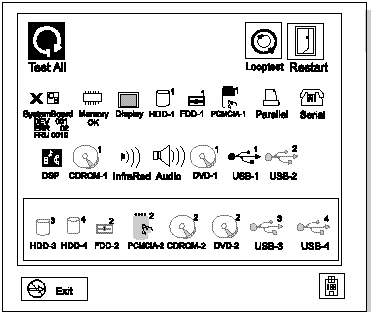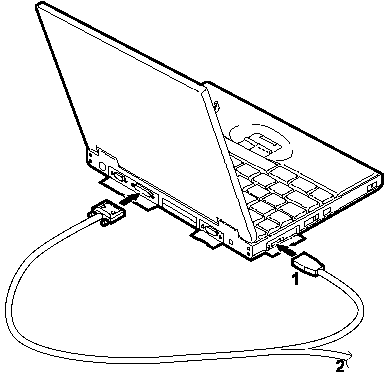

|
62.368 bytes |
Service Hints & Tips |
Document ID: LWIK-3SUHTX |
TP 600 - Running Diagnostics
Applicable to: World-Wide
The following table lists the special tools needed for the diagnostics:

Use either the TrackPoint or the cursor-moving keys to interact with the tests. The Enter key works the same as selecting the OK icon to reply OK.
1. Press and hold F1; then power on the computer. Hold F1 down until the Easy-Setup menu appears.
2. Click on Test. The basic diagnostic menu appears.
3. Click on a device to run the test. The test progress screen appears; then OK appears under the tested device icon when the test ends without any errors.
4. Start the Advanced Diagnostic test by pressing Ctrl+A on the basic diagnostic menu. The ThinkPad FRU connections window appears.
5. Click on Exit or press the Esc key. The keyboard test window appears.
6. When you press a key, a mark appears or disappears on the corresponding key position on the screen. Repeat this step for any keys that need to be tested.
You can run the keyboard test if you press Ctrl+K key in the advanced diagnostic test mode.
7. To exit the keyboard test, click on Exit or press Ctrl+Break. The advanced diagnostics window appears:

8. Click on a device to test it, or click on Test All to test all devices. Click on Looptest to run the tests in a repeated loop. The loop option menu appears. Click on a device; the  mark appears beside the selected device. Repeat this step to select multiple devices. Click on OK to start the diagnostic loop. If no device is
mark appears beside the selected device. Repeat this step to select multiple devices. Click on OK to start the diagnostic loop. If no device is
selected, all devices tests are looped.
9. To exit the loop, keep pressing Ctrl+Pause until the test exits. A beep sounds to notify that the exit interrupt is sensed by the test program. Press Esc to exit from the loop test.
PC Card (PCMCIA) Slots Test
The green LED on the PC test card (P/N 35G4703) turns on when the PC Card (PCMCIA) slot test is running. If the LED does not turn on, check that the card is installed correctly by reseating it. If the LED still does not turn on after the card is reseated, try using another slot for the test. If the LED still does not turn on and the test fails, replace the FRU shown by the diagnostic error code.
Universal Serial Bus (USB) Test
At the advanced diagnostic window, connect the USB parallel test cable (P/N 05K2580) to the computer, as shown:

Click on  to run the test. Follow the instructions on the screen. OK appears if the test passed, but three lines of error codes appear if the test failed. The defective FRU must be the system board.
to run the test. Follow the instructions on the screen. OK appears if the test passed, but three lines of error codes appear if the test failed. The defective FRU must be the system board.
Use the cable number 2 for the USB port on a port replicator. Click on 
If you want to test the USB ports on a docking station, connect both cables (number 1 and 2) to the USB ports and click on  and
and  .
.
Displaying the Error Log
Diagnostic errors are printed on a printer attached to the parallel port when the error is detected. The error is also logged in the system memory.
Use the following procedure to display the errors:
1. Enter the advanced diagnostic test.
2. Press Ctrl+E.
3. The error log appears.
4. To exit the screen, click on Exit or press Esc.
The error log is not saved when system power is turned off.
Checking the Installed Devices List
If a device is installed but the icon appears in a gray shade rather than a dark shade on the basic diagnostics menu, the device is defective. Reseat the device connectors. If the symptom remains, replace the device or the system board. If needed, adjust the contrast control to clearly distinguish the shades of the icon.
If a device that is not installed appears in a dark shade (for example, FDD-2 appears in a dark shade when no second FDD is installed), do the following:
1. Replace the first device in the configuration, such as an FDD-1.
2. If the problem persists, replace the system board.
The Parallel, and Serial icons are always displayed in a dark shade, because the icons represent subsystems of the system board and not the attachment of devices.
The FDD-1 icon represents a device in the UltraslimBay.
The FDD-2 icon represents another device, such as:
o An external diskette drive attached to the computer
o An external diskette drive attached to a port replicator
o A diskette drive in a docking station
|
Search Keywords |
| |
|
Hint Category |
Hardware Maintenance Information | |
|
Date Created |
23-03-98 | |
|
Last Updated |
19-01-99 | |
|
Revision Date |
19-01-2000 | |
|
Brand |
IBM ThinkPad | |
|
Product Family |
ThinkPad 600 | |
|
Machine Type |
2645, 2646 | |
|
Model |
Various | |
|
TypeModel |
| |
|
Retain Tip (if applicable) |
| |
|
Reverse Doclinks |